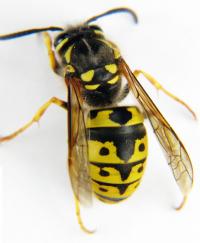
Bees and Wasps
Bees and wasps are most active during the warmer months in Oklahoma City and can be a nuisance to any lover of the outdoors. Their stings can bring an end to an enjoyable summer event quickly! For most, a bee or wasp sting will cause pain, redness, and minor swelling. For some, a more serious allergic reaction may occur. If this happens seek immediate emergency care. To prevent most bee or wasp stings wear light-colored clothing while outdoors, don’t wear perfumes, do not use soda cans (they may crawl inside) keep lids on all of your garbage cans and of course, call a professional to have unwanted nests removed.
Mud Dauber
The mud dauber constructs their nests from mud and do not live in colonies. Their favorite food is spiders and they rarely sting humans. The mud dauber nests can sometimes be adopted by more dangerous wasps species though so if you see abandoned nests it is best to call The Bug Guy to remove it for you.
Yellow Jacket
The yellow jacket is a species of wasp that is very aggressive and territorial. They prefer undisturbed areas like attics, soffits, sheds and underground locations that protect them from the weather. Yellow Jackets are capable of stinging repeatedly and may induce a severe reaction in some people. To prevent yellow jackets from taking over your backyard, do not leave food out (including pet food), make sure the trash can in covered at all times and seal gaps on the exterior or your home.
Black Widow Spider
The black widow spider can be found throughout North America but is most common in the southern and western parts of the United States. It is identified by an hourglass red marking on the underside of its abdomen. Black Widow spiders like undisturbed locations away from human activity such as woodpiles, storage bins, patio furniture and cellars and most bites occur when their nests are disturbed. The black widow bite may feel like a pinprick, although some victims may not feel anything. There may be swelling and redness near the bite area, as well as a target-shaped lesion, and within an hour a dull muscle pain can spread to the rest of the body. If possible, collect the spider in a container for identification. Seek immediate medical attention.
Brown Recluse Spider
The brown recluse is a spider many Oklahomans are familiar with. The brown recluse is often called “fiddleback” because of its violin-shaped marking on its back, the brown recluse is most common in south central states of the United States, including Oklahoma. Most brown recluse spiders and their webs will be found near ground level, and they can be found both indoors and outdoors. They prefer dark and quiet areas like closets, behind and under furniture and in shoes. The brown recluse bite can be painless or you may feel a sharp sting. Severe symptoms and pain may take several hours to appear. If you see the spider bite you, attempt to collect the spider in a container. Children may have more serious reactions. Seek medical attention immediately.
Fire Ants
Fire ants attack by biting to get a grip on the skin and then stinging their victim. Their sting releases a painful venom which is where the “fire” in the name fire ants comes from. The severity of a sting varies from person to person. For some, this sting causes a painful or itchy bump, but for others, the sting of the fire ant can cause a dangerous allergic reaction. You can reduce your risk of fire ant stings by having The Bug Guy check for and get rid of ant nest near your home, avoiding ant nests (be especially careful when mowing the lawn), wearing shoes and socks while walking in the yard and wearing work gloves when you garden.
Hobo Spider
While there has been some debate on the danger of hobo spiders recently, the Center for Disease Control still lists the hobo spider as one of the venomous spiders that can be found in the United States and Oklahoma. The Hobo Spider can be very difficult to identify without the aid of microscopes, and is sometimes confused with the Brown Recluse. Preferring humid environments, they set up their funnel-shaped webs in homes and offices as well as outdoors – among storage items, baseboards, window sills or near stacks of firewood. The hobo spider bite may go unnoticed at first, but will soon develop into a slow-healing wound. Some symptoms are more severe and immediate. If possible, collect the spider in a container for identification. Seek immediate medical attention.
Mosquito
The mosquito causes more human suffering than any other animal. More than 1 Million people die every year and 300-500 million people are sickened as a result of mosquito-borne diseases like Zika, Malaria, Yellow fever, West Nile Virus and St. Louis Encephalitis. In Oklahoma, there are many different kinds of mosquitoes and not all of those carry diseases or parasites that will make people sick. You can reduce your risk of being bitten by mosquitoes by
- draining or removing standing water from your property
- wearing long sleeves and pants and spraying your clothes with insect repellent containing DEET
- staying indoors at dusk and dawn when mosquitoes are most active.
Scorpion
Between 3 to 5 species of scorpion are believed to live in Oklahoma, but only one species is common throughout the entire state. Scorpions prefer undisturbed, outdoor areas like those under rocks, leaves, or loose bark around trees. When found indoors, the scorpion is often found in bathrooms or kitchens, or in a dark area where water is available. The scorpion sting usually occurs when stepped on, handled or bothered in some way. To prevent scorpions in your home regular treatments from The Bug Guy are recommended as well as removing objects like bricks and logs that may be around the home, keeping the grass mowed near the house and eliminating clutter in the attack, garage and crawl space.
Stinging Caterpillar
There are a few stinging caterpillars in Oklahoma to be wary of and it is important to note that not all caterpillars are stinging caterpillars. A caterpillar sting is the result of a contact and not a deliberate attack on the victim and will usually occur inadvertently while outdoors. The type of reaction will vary from person to person based on allergies and skin type, but also by the type of caterpillar. Sting reactions can range from mild to painful and a rash or other symptoms may occur. If you think you may be having an allergic reaction seek medical attention immediately.
Ticks
Ticks are a little like mosquitoes, in that not all ticks carry diseases but those that do can cause some serious illnesses to their victims. Ticks lay in wait in grasses until an animal or human host walks by and then crawls onto the host to feed. Most diseases are transmitted to the host during the feeding process. Lyme Disease, Rocky Mountain Spotted Fever, and Heartland Virus are a few of the diseases that can be transmitted from a tick. The rare Bourbon virus has also been diagnosed in Oklahoma. To reduce tick populations near your home, remove leaf litter, cut back tall grass and brush and discourage deer activity. If you are in an area known for ticks, use repellents containing 20-30% DEET on exposed skin and clothing and check all areas of your skin carefully when returning to the indoors. Some may be very small to see and you may need a partner to help you.

